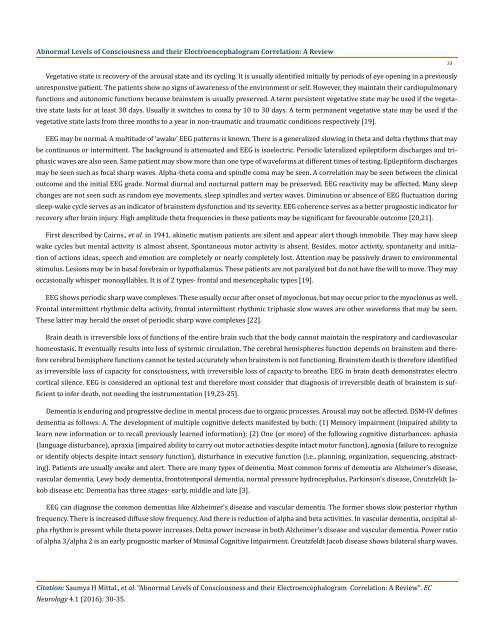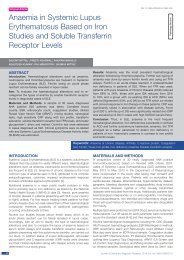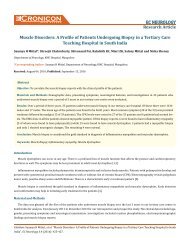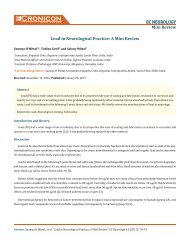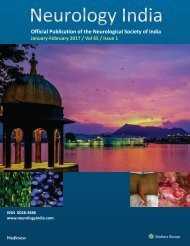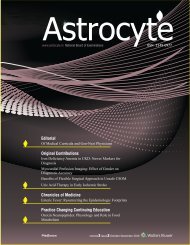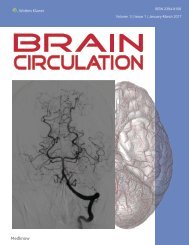Abnormal Levels of Consciousness and their Electroencephalogram Correlation- A Review
You also want an ePaper? Increase the reach of your titles
YUMPU automatically turns print PDFs into web optimized ePapers that Google loves.
<strong>Abnormal</strong> <strong>Levels</strong> <strong>of</strong> <strong>Consciousness</strong> <strong>and</strong> <strong>their</strong> <strong>Electroencephalogram</strong> <strong>Correlation</strong>: A <strong>Review</strong><br />
Vegetative state is recovery <strong>of</strong> the arousal state <strong>and</strong> its cycling. It is usually identified initially by periods <strong>of</strong> eye opening in a previously<br />
unresponsive patient. The patients show no signs <strong>of</strong> awareness <strong>of</strong> the environment or self. However, they maintain <strong>their</strong> cardiopulmonary<br />
functions <strong>and</strong> autonomic functions because brainstem is usually preserved. A term persistent vegetative state may be used if the vegetative<br />
state lasts for at least 30 days. Usually it switches to coma by 10 to 30 days. A term permanent vegetative state may be used if the<br />
vegetative state lasts from three months to a year in non-traumatic <strong>and</strong> traumatic conditions respectively [19].<br />
EEG may be normal. A multitude <strong>of</strong> ‘awake’ EEG patterns is known. There is a generalized slowing in theta <strong>and</strong> delta rhythms that may<br />
be continuous or intermittent. The background is attenuated <strong>and</strong> EEG is isoelectric. Periodic lateralized epileptiform discharges <strong>and</strong> triphasic<br />
waves are also seen. Same patient may show more than one type <strong>of</strong> waveforms at different times <strong>of</strong> testing. Epileptiform discharges<br />
may be seen such as focal sharp waves. Alpha-theta coma <strong>and</strong> spindle coma may be seen. A correlation may be seen between the clinical<br />
outcome <strong>and</strong> the initial EEG grade. Normal diurnal <strong>and</strong> nocturnal pattern may be preserved. EEG reactivity may be affected. Many sleep<br />
changes are not seen such as r<strong>and</strong>om eye movements, sleep spindles <strong>and</strong> vertex waves. Diminution or absence <strong>of</strong> EEG fluctuation during<br />
sleep-wake cycle serves as an indicator <strong>of</strong> brainstem dysfunction <strong>and</strong> its severity. EEG coherence serves as a better prognostic indicator for<br />
recovery after brain injury. High amplitude theta frequencies in these patients may be significant for favourable outcome [20,21].<br />
First described by Cairns., et al. in 1941, akinetic mutism patients are silent <strong>and</strong> appear alert though immobile. They may have sleep<br />
wake cycles but mental activity is almost absent. Spontaneous motor activity is absent. Besides, motor activity, spontaneity <strong>and</strong> initiation<br />
<strong>of</strong> actions ideas, speech <strong>and</strong> emotion are completely or nearly completely lost. Attention may be passively drawn to environmental<br />
stimulus. Lesions may be in basal forebrain or hypothalamus. These patients are not paralyzed but do not have the will to move. They may<br />
occasionally whisper monosyllables. It is <strong>of</strong> 2 types- frontal <strong>and</strong> mesencephalic types [19].<br />
EEG shows periodic sharp wave complexes. These usually occur after onset <strong>of</strong> myoclonus, but may occur prior to the myoclonus as well.<br />
Frontal intermittent rhythmic delta activity, frontal intermittent rhythmic triphasic slow waves are other waveforms that may be seen.<br />
These latter may herald the onset <strong>of</strong> periodic sharp wave complexes [22].<br />
Brain death is irreversible loss <strong>of</strong> functions <strong>of</strong> the entire brain such that the body cannot maintain the respiratory <strong>and</strong> cardiovascular<br />
homeostasis. It eventually results into loss <strong>of</strong> systemic circulation. The cerebral hemispheres function depends on brainstem <strong>and</strong> therefore<br />
cerebral hemisphere functions cannot be tested accurately when brainstem is not functioning. Brainstem death is therefore identified<br />
as irreversible loss <strong>of</strong> capacity for consciousness, with irreversible loss <strong>of</strong> capacity to breathe. EEG in brain death demonstrates electro<br />
cortical silence. EEG is considered an optional test <strong>and</strong> therefore most consider that diagnosis <strong>of</strong> irreversible death <strong>of</strong> brainstem is sufficient<br />
to infer death, not needing the instrumentation [19,23-25].<br />
Dementia is enduring <strong>and</strong> progressive decline in mental process due to organic processes. Arousal may not be affected. DSM-IV defines<br />
dementia as follows: A. The development <strong>of</strong> multiple cognitive defects manifested by both: (1) Memory impairment (impaired ability to<br />
learn new information or to recall previously learned information); (2) One (or more) <strong>of</strong> the following cognitive disturbances: aphasia<br />
(language disturbance), apraxia (impaired ability to carry out motor activities despite intact motor function), agnosia (failure to recognize<br />
or identify objects despite intact sensory function), disturbance in executive function (i.e., planning, organization, sequencing, abstracting).<br />
Patients are usually awake <strong>and</strong> alert. There are many types <strong>of</strong> dementia. Most common forms <strong>of</strong> dementia are Alzheimer’s disease,<br />
vascular dementia, Lewy body dementia, frontotemporal dementia, normal pressure hydrocephalus, Parkinson’s disease, Creutzfeldt Jakob<br />
disease etc. Dementia has three stages- early, middle <strong>and</strong> late [3].<br />
EEG can diagnose the common dementias like Alzheimer’s disease <strong>and</strong> vascular dementia. The former shows slow posterior rhythm<br />
frequency. There is increased diffuse slow frequency. And there is reduction <strong>of</strong> alpha <strong>and</strong> beta activities. In vascular dementia, occipital alpha<br />
rhythm is present while theta power increases. Delta power increase in both Alzheimer’s disease <strong>and</strong> vascular dementia. Power ratio<br />
<strong>of</strong> alpha 3/alpha 2 is an early prognostic marker <strong>of</strong> Minimal Cognitive Impairment. Creutzfeldt Jacob disease shows bilateral sharp waves.<br />
33<br />
Citation: Saumya H Mittal., et al. “<strong>Abnormal</strong> <strong>Levels</strong> <strong>of</strong> <strong>Consciousness</strong> <strong>and</strong> <strong>their</strong> <strong>Electroencephalogram</strong> <strong>Correlation</strong>: A <strong>Review</strong>”. EC<br />
Neurology 4.1 (2016): 30-35.


